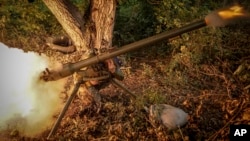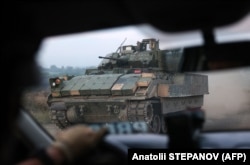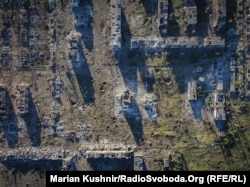Ukraine has repeatedly crossed the border into Russia since the start of Moscow's all-out invasion: intelligence operatives doing clandestine operations; drones targeting airfields hundreds of kilometers away; ragtag, unofficial militia groups raiding border villages.
This time, it's different.
Hundreds of uniformed Ukrainian troops, backed by armored vehicles and other heavy equipment, this week punched into Russia’s Kursk region north of the Ukrainian city of Sumy. As of August 9, the troops had seized control of about 600 square kilometers of territory, and more than two dozen settlements, according to local officials, pro-war bloggers, and open-source intelligence reports.
The head-snapping incursion -- the largest by Ukrainian forces since Russia launched the invasion in February 2022 -- comes as Ukrainian troops struggle to hold back Russian advances in at least three locations across the 1,100-kilometer front line further to the south. Russian troops are nearing a major Donbas highway whose capture would threaten Ukrainian supply lines along the entire front.
"The situation in general is not good for Ukrainian forces," said Ivan Stupak, a Ukrainian military expert and former intelligence officer. For Russia, "the main idea is to split the Ukrainian armed forces into two pieces; split the enemy and to try and destroy them part by part, step by step. It's much easier to destroy that way."
Confused? Here's what the battlefield looks like nearly 900 days into the biggest land war in Europe since World War II.
The Bad News For Ukraine
To the southeast of the logistical hub of Pokrovsk, the situation is "much more dangerous" and "critical," according to military experts and open-source analysts. Momentum there turned toward Russia in April, when its forces took the village of Ocheretyne amid a Ukrainian troop rotation that some reports say was botched, and they have steadily moved west and north since then.
As of August 6, Russian forces were reported on the eastern outskirts of Vozdvyzhenka, a village located about 5 kilometers from the T-0504 highway.
"The situation in the Pokrovsk direction is extremely difficult," said the Center for Defense Strategies, a Kyiv think tank headed by a former Ukrainian defense minister.
Running out of Pokrovsk is a highway, known variously as the N23 or the T-0504, that heads east and then northeast toward Kostyantynivka, a railway junction city that has served a critical supply line for Ukrainian troops.
Russia wants the highway badly.
Taking the road, which is used to shuttle ammunition and supplies, as well as transport of wounded soldiers, would be a major rupture of Ukrainian supply lines.
The road is not the only route in this section of the battlefield, Stupak said. But it's the best one: Other routes might be more circuitous and unpaved, meaning slower driving speeds -- and when the weather turns and autumn rains begin, Ukraine's legendary mud will make them nearly impassable.
"If you cut the road, [Ukrainian] forces will start suffering," he said. "It's not the end of the war, but it's also not good."
Feint And Parry
If nothing dramatic changes in the coming days and weeks, Russia will get the highway, putting Ukraine's fraying defenses in an even more tenuous position.
Which may be why Ukraine decided to invade Russia.
“To say that this incursion into the Kursk Oblast caught many, including the Russian command, by surprise is an understatement,” said one Ukrainian military observer who writes under the name Tatarigami.
For three days after the initial reports of the raid, Ukrainian officials said nothing, aside from suggestions that official Russian reports were grossly understating its scale. On August 8, President Volodymyr Zelenskiy also offered a hint.
"Everyone can see that the Ukrainian army knows how to surprise. And knows how to achieve results," he said at an event.
Mykhaylo Podolyak, a top Zelenskiy adviser, made a less veiled confirmation.
“War is war, with its own rules, where the aggressor inevitably reaps corresponding outcomes,” Podolyak said in a post to Telegram.
But Russian authorities, military bloggers, and local officials and residents point to an unusually large invading force, with armored vehicles and even tanks, that has moved quickly, overcoming light Russian defenses and undermanned border guard units. Analysts said the vehicles involved, including U.S.-supplied Stryker armored vehicles, pointed to the 22nd Mechanized Brigade -- one of Ukraine’s more battle-hardened units -- as leading the charge.
Satellite imagery and reports by Deep State, an open-source organization with ties to the Ukrainian Army, suggested troops had advanced as far as 90 kilometers from the border in some places. Russian military bloggers point to similar advances. Estimates from both Russian and Ukrainian analysts as to the amount of territory captured ranged from 500 to 600 square kilometers as of August 9.
Russian President Vladimir Putin called a session of his Security Council on August 7, and he opened the meeting with televised remarks calling the offensive a "large-scale provocation." Russia's top military commander, General Valery Gerasimov, said the force might be the size of an entire battalion: as many as 1,000 men.
Residents of a Kursk region border town, Sudzha, posted an angry video to Telegram on August 8, saying Putin was being misled by his commanders as to the scale of the invasion.
“These lies are making the residents die,” one woman said. Military commanders “told you the situation is under control, but today huge battles are under way” in the district.
The goal of the operation is unclear, and analysts say chances of a major tactical success are slim. Diverting an experienced battalion-sized unit from the front line to stage an uncertain incursion is problematic: Ukrainian commanders do not have deep reserves of men or equipment at their disposal, which is why units across the Donbas front have been unable to check Russian advances.
Ukraine also did not notify its biggest supplier of weaponry, the United States, before conducting the incursion.
In June, as Russian forces pressed a localized cross-border offensive northeast of Kharkiv, the U.S. administration softened a standing policy and gave the green light for Ukraine to use U.S. weaponry to hit Russian targets inside Russia.
Despite not getting advance notice, the administration did not consider the incursion a violation of the wider U.S. prohibition, U.S. officials said.
“It is consistent with our policy and we have supported Ukraine from the very beginning to defend themselves against attacks that are coming across the border,” Pentagon spokeswoman Sabrina Singh said August 8.
Crossing The Canal
About 55 kilometers northeast of Pokrovsk, at the other end of the T-0504 highway, is Kostyantynivka, with a railway spur that runs northwest to Slovyansk and Kramatorsk -- bigger, heavily fortified cities where Ukrainian forces have hospitals, forward command posts, and other critical infrastructure.
Russia wants Kostyantynivka, but in order to occupy it, Moscow's forces need to take Chasiv Yar, a height-of-land city with a manmade waterway, the Siverskiy Donets–Donbas Canal, that splits the town's main district from the eastern Kanal district.
Russian troops occupied all of the Kanal district sometime in June, and have pushed forward to the canal itself, which is a natural defense that the Ukrainians have relied heavily on. Over the past months, small groups of Russian soldiers have tried to cross the canal and establish positions on its west side. Other Russian units have also tried to flank the canal from the north and south.
"The Russians attack in small groups. They drive all the way to a hideout in light vehicles, gather a few people, and then this small group starts to storm and reach the positions of our guys without being noticed," Andriy Polukhin, a spokesman for the 24th King Danylo Mechanized Brigade, told RFE/RL's Ukrainian Service. "But at the moment, it is not true; [Russian troops] crossing the canal and positioning on the other side. This has not happened."
Serhiy Hrabskiy, a retired Ukrainian Army colonel, said the attacking Russian units are still dismounted infantry -- units that do not have cover from tanks or artillery.
For Ukraine, "the tactic is exhausting, but the Russians are still able to advance with…numerical superiority. The question is how long they can continue in such a manner," he said.
Nyu-York: A Hell Of A Town
To the east of Pokrovsk, Russian units have successfully pushed a bulge, a salient, in Ukrainian lines, toward Nyu-York, which is frequently spelled New York. On August 7, Russian military bloggers reported that Russian troops had entered one of the town's districts.
The Russian bulge at Nyu-York puts more pressure on Ukrainian defenses just to the north, at the city of Toretsk, where Russian troops have also gradually crept forward.
Capturing Toretsk would give Russia control of a wider, sprawling urban region that includes the main regional city, Donetsk, and places like Horlivka, Makiyivka, and other industrial locations, Hrabskiy said. Capturing Toretsk will also threaten Kostyantynivka, 22 kilometers to the northwest.
"Will it cause a total break in Ukrainian positions? No, because the Ukrainians have been able to build other defensive lines," he said.
Wait, Didn't Ukraine Just Mobilize Its Population?
Manpower has been one of the biggest problems Ukrainian commanders have grappled with. While Russia has been able to replenish its units by enticing volunteers with extraordinarily high wages and benefits, Ukraine was slow in passing legislation to codify mobilization rules.
With passage of the law in May, Ukrainian recruiters were able to start getting men into the pipeline for training and equipping. Some frontline units have already reported the arrival of new recruits, and Hrabskiy said the bulk of the newest soldiers should appear by mid-September.
"To be honest, I'm surprised how our guys are able to hold their lines. They're completely exhausted, not enough men, not enough ammunition," he said.
That should stabilize the front lines, Hrabskiy predicted, but mounting another counteroffensive -- like two successful drives in 2022 or the one that fizzled last year -- is likely impossible for now.
"I'm doubtful that Ukrainian forces will be able to do anything before the middle of 2025," he said.


